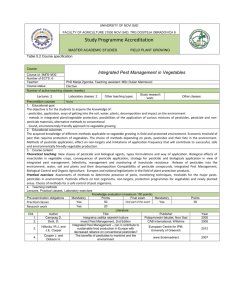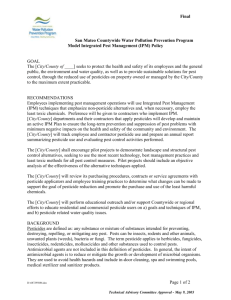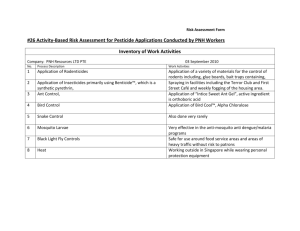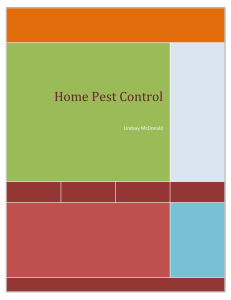Pest Management Regulatory Agency
advertisement
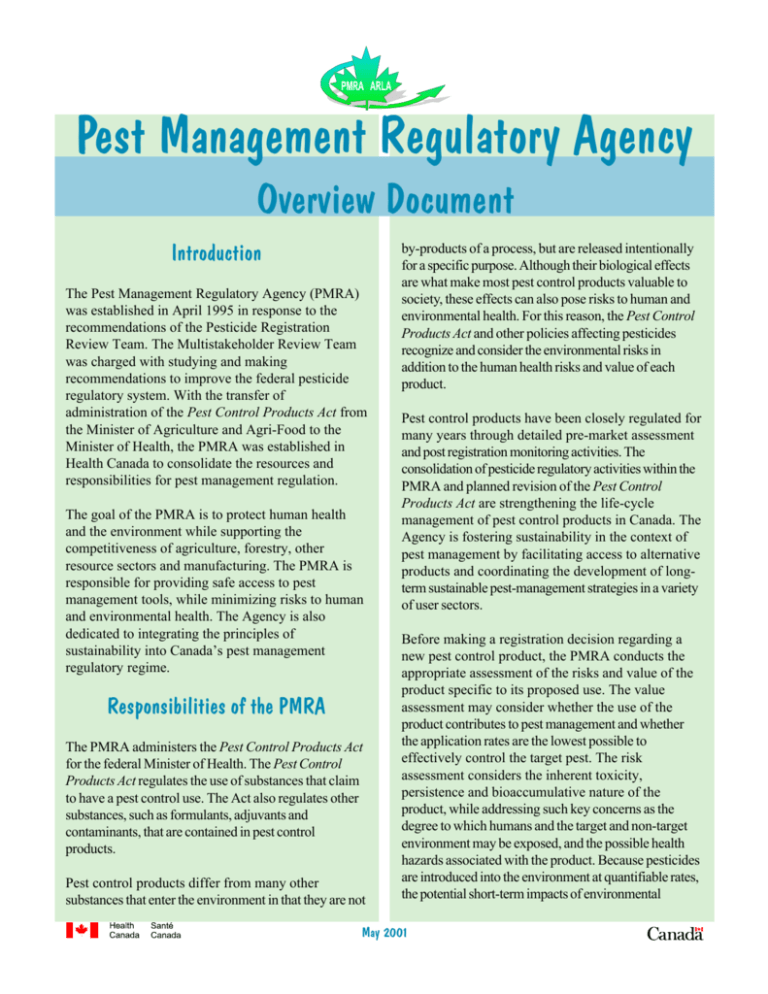
Pest Management Regulatory Agency Overview Document Introduction The Pest Management Regulatory Agency (PMRA) was established in April 1995 in response to the recommendations of the Pesticide Registration Review Team. The Multistakeholder Review Team was charged with studying and making recommendations to improve the federal pesticide regulatory system. With the transfer of administration of the Pest Control Products Act from the Minister of Agriculture and Agri-Food to the Minister of Health, the PMRA was established in Health Canada to consolidate the resources and responsibilities for pest management regulation. The goal of the PMRA is to protect human health and the environment while supporting the competitiveness of agriculture, forestry, other resource sectors and manufacturing. The PMRA is responsible for providing safe access to pest management tools, while minimizing risks to human and environmental health. The Agency is also dedicated to integrating the principles of sustainability into Canada’s pest management regulatory regime. Responsibilities of the PMRA The PMRA administers the Pest Control Products Act for the federal Minister of Health. The Pest Control Products Act regulates the use of substances that claim to have a pest control use. The Act also regulates other substances, such as formulants, adjuvants and contaminants, that are contained in pest control products. Pest control products differ from many other substances that enter the environment in that they are not by-products of a process, but are released intentionally for a specific purpose. Although their biological effects are what make most pest control products valuable to society, these effects can also pose risks to human and environmental health. For this reason, the Pest Control Products Act and other policies affecting pesticides recognize and consider the environmental risks in addition to the human health risks and value of each product. Pest control products have been closely regulated for many years through detailed pre-market assessment and post registration monitoring activities. The consolidation of pesticide regulatory activities within the PMRA and planned revision of the Pest Control Products Act are strengthening the life-cycle management of pest control products in Canada. The Agency is fostering sustainability in the context of pest management by facilitating access to alternative products and coordinating the development of longterm sustainable pest-management strategies in a variety of user sectors. Before making a registration decision regarding a new pest control product, the PMRA conducts the appropriate assessment of the risks and value of the product specific to its proposed use. The value assessment may consider whether the use of the product contributes to pest management and whether the application rates are the lowest possible to effectively control the target pest. The risk assessment considers the inherent toxicity, persistence and bioaccumulative nature of the product, while addressing such key concerns as the degree to which humans and the target and non-target environment may be exposed, and the possible health hazards associated with the product. Because pesticides are introduced into the environment at quantifiable rates, the potential short-term impacts of environmental May 2001 Overview Document exposures can be closely estimated. For long-term exposure, the PMRA relies on persistence and bioaccumulation data as qualitative indicators, as well as on any monitoring data available. on reproduction and development, damage to genetic material and other effects that may impair health. For this reason, an extensive battery of toxicity studies is required to determine the nature and extent of the hazard posed by a pest control product proposed for use in Canada. For registered products, ongoing surveillance, advances in analytical methods and improved evaluation processes provide a means to uncover environmental or health concerns, particularly with older products. The required studies are designed to assess the possible adverse health effects on a variety of species that may result from single, multiple or lifetime exposure to a pest control product via the skin, mouth, lungs or eyes. A variety of species are used to indicate whether the same effects are observed in different species, or if they are limited to a certain species. Metabolic and toxicokinetic information are also key, because they provide valuable information on rates of absorption, distribution and excretion in mammalian systems, as well as a profile of metabolites that are likely to be present. Pest control products will be registered if: the data requirements for assessing value and safety have been adequately addressed; the evaluation indicates that the product has merit and value; and the human health and environmental risks associated with its proposed use are acceptable. The PMRA manages the risks associated with pesticide use in several ways. These include: ä setting conditions of registration; ä monitoring compliance with conditions of registration; ä developing label improvement programs that support best-management practices; and ä supporting the development of sustainable pestmanagement strategies that provide a context for registration decisions. The following is a description of major studies that could be found in the health portion of a data package. In addition to being conducted on the pesticide itself, studies may also be conducted on metabolites. Acute toxicity studies are designed to provide information about adverse health effects that may result within about two weeks of exposure to high doses of pesticides. A typical acute toxicity data package comprises studies that determine the bodily effects resulting from the most common routes of exposure (mouth, skin and lungs), as well as skin and eye irritation and skin sensitization studies. These studies provide the information necessary to make recommendations for safe handling practices, and help to indicate appropriate doses for longer-term studies. Acute hazards are indicated on the product label to prevent poisonings. Non-compliance with conditions of registration is a violation of the Pest Control Products Act and may lead to suspension, cancellation, use restrictions or the phasing out of a pest control product. Health Evaluation It is generally recognized that pesticides may pose a hazard to human health. Possible adverse health effects include cancer, birth defects, adverse effects 2 Overview Document Short-term toxicity studies determine the effects of repeated exposure to a pesticide over a short period of time, usually from three weeks to three months. These studies also examine effects resulting from the most common routes of exposure (mouth, skin and lungs). The results of these studies enable toxicologists to identify the tissues and organs that are susceptible to damage from exposure to a range of pesticide doses, to establish doses that are tolerated by the test animals, and to determine suitable doses for use in long-term toxicity studies. pregnant animals during the most sensitive stages of development. These studies provide evidence regarding toxicity to the pregnant animal, as well as to the embryo and fetus. Genetic toxicity studies are conducted to determine whether the pesticide may interact with genetic material, resulting in mutations and other damage (e.g., chromosome breaks), or interference with normal genetic processes. This information is often used in conjunction with information from the carcinogenicity assessment to help determine possible mechanisms of action for observed effects. Long-term toxicity and carcinogenicity studies determine the effects of exposure to a test substance over most of the test animal’s lifetime (e.g., 2 years for rats, 18 months to 2 years for mice). Extensive information on systemic toxicity and carcinogenicity is generated through the examination of organs and tissues, as well as through the biochemical and pathological analysis of blood and urine. It is critical that the doses selected for the conduct of these studies provide a range of responses, including a dose(s) that results in no observable adverse effects and a dose(s) that results in overt toxicity. Metabolism and toxicokinetics studies provide information about the relative amount of the product that is likely to be absorbed into the body, the relative distribution of the absorbed dose among the tissues, and the rates and routes of excretion (e.g., urine, feces, bile, expired air). Metabolites are identified, as is the relative proportion of each metabolite that may be expected through mammalian metabolic pathways. Other endpoints Reproductive and developmental toxicity studies are designed to generate information on possible effects on growth and reproduction, and are conducted over at least two generations. The dosing period includes pre-treatment of males through the period of sperm development and of females through at least one ovulatory cycle. The offspring are exposed to the pesticide through the maternal milk supply until weaning, when they are fed diets containing the pesticide. Neurotoxicity studies are required for pesticides, such as organophosphorous insecticides, that are likely to affect nervous tissue. A variety of neurotoxicity studies may be required to determine a pesticide’s mechanism of neurotoxic action. Immunotoxicity is evaluated in the course of examining subchronic and chronic toxicity studies. Certain parameters, such as organ weights (e.g., thymus, spleen) and/or differential white blood cell counts, provide an indication of potential interference with normal immune function. If a concern is identified, further specific immunotoxicity studies may be required. Teratology studies are designed to determine whether a chemical may cause adverse effects on the developing fetus. The test substance is administered to 3 Overview Document Endocrine disruptor potential (such as interference with the production of sex hormones) is evaluated in the course of examining the information from reproduction, teratology, and short- and long-term toxicity studies. If the results of these studies indicate the need for further information regarding interference with normal endocrine function, additional testing may be required. In occupational/bystander risk assessments, the most appropriate NOAEL (based on such considerations as route and duration of exposure, species tested in toxicity studies, and the endpoint of toxicological concern) is divided by estimated exposure to determine the margin of safety. Typically, a margin of safety of 100 is considered acceptable to account for potential variability in response, both within the same species (i.e., adults versus children) and between species (i.e., rodents versus humans). Alternatives to animal tests In evaluating the safety of food residues, the most appropriate NOAEL is divided by a safety factor, usually of 100. This number may be lower or higher, depending on a number of factors considered in the hazard assessment, such as the type of effect observed. The resulting figure provides the acceptable daily intake—the amount of the pesticide that toxicologists consider safe for humans to consume each day for an entire lifetime. A maximum residue limit is established for each food by first determining the amount of pesticide likely to remain in or on food at the point of sale. The maximum residue limit is accepted only if total consumption of residues from all foods (including consideration of different consumption patterns, such as those of children) will not exceed the acceptable daily intake for that particular pesticide. The scientific community is devoting a significant amount of effort to the development of alternatives to animal testing, particularly in the area of eye irritation. Efforts include the development of in vitro methods. In addition, computer programs are available that may predict potentially-hazardous materials through structure/activity relationships. At present, these alternatives are of limited use in regulatory programs where more reliable information from animal tests is still routinely required. However, they are quite useful in determining priorities for testing chemicals that have not been subjected to rigorous toxicity testing. Risk assessment Risk assessment combines the results of the hazard assessment (i.e., the evaluation of scientific studies) with those of the exposure assessment. Scientists in the PMRA determine the no observed adverse effect levels (NOAELs) from the information provided by the studies described above. Environmental Risk Assessment Scientific data on the environmental fate and environment toxicology of a pesticide are part of the information package required to support registration. Canadian environmental data requirements for major forestry and agricultural uses of chemical pesticides have been harmonized with U.S. requirements, and are similar to those of other pesticide regulatory systems. The Assessment of cancer risks involves challenges that warrant special consideration. The PMRA’s approach to cancer risk-assessment is based on the weight of the scientific evidence obtained through the evaluation of the entire data package. 4 Overview Document PMRA conducts a critical evaluation of these data to determine the environmental risk of a pesticide. dispersion of the biological agents. Information on fate may not be required if toxicity tests indicate minimal environmental concern. Similarly, with pheromones and other semiochemicals, environmental fate data are required only when tests indicate toxicity to non-target organisms. The environmental risk posed by a pesticide is a function of: ä environmental fate—i.e., what happens to the pesticide once it enters the environment, including expected environmental concentrations to which non-target organisms may be exposed; and ä environmental toxicology—i.e., the hazards posed by the pesticide to non-target plants and animals, both on land and in bodies of water. The determination of the fate of a chemical pesticide takes into account the following aspects: Physical and chemical properties: Physical and chemical properties of a pesticide are obtained from laboratory studies and are essential for the prediction of environmental behaviour. These properties include water solubility, which is useful in predicting pesticide mobility in soil and deposition into sediments in an aquatic environment. Vapour pressure is a key indicator of the potential of a compound to volatilize. The octanol/water partitioning coefficient (Kow) indicates the likelihood of a pesticide transfer from soil or water to organisms, as well as the pesticide’s potential to bioaccumulate. If the Kow indicates a potential to bioaccumulate, a laboratory bioaccumulation study would be required for confirmation purposes. Environmental fate Environmental fate provides an indication of what happens to a pesticide once it enters the environment, as well as likely exposure levels for non-target organisms. Evaluation of the data makes it possible to determine the behaviour of a pesticide in soil, water and air, the potential for its uptake by plants or animals, and the potential for bioaccumulation in organisms. Data on the proposed use-pattern are used in determining the fate and expected environmental concentrations of a pesticide in various compartments of the environment. These data include details on: ä rates and methods of application; ä number of applications per season; ä times of application; ä target pests; ä target crops/resources; and ä geographic area. Transformation processes: Pesticides in the environment may undergo transformations or degradation due to reactions caused by light, chemical reactions, biological reactions, or a combination of these phenomena. Therefore, it is important to review data on phototransformation (reactions caused by light), hydrolysis (chemical reactions) and biotransformation (biological reactions) in order to determine their significance in the transformation of the pesticide in different environmental media. In addition to providing answers on transformation pathways, biotransformation studies are designed to provide information on persistence under both aerobic Evaluation of the fate and behaviour of microbial or other biological control agents is based on a study of the identity, biology, persistence, multiplication and 5 Overview Document and anaerobic conditions. These studies aid in the design of field studies, which are necessary to confirm laboratory-based predictions. Aquatic field studies are required where there is a high potential for the parent compound or the major transformation product to enter aquatic systems and to directly or indirectly affect non-target aquatic organisms. Water and sediment samples are taken at regular intervals for residue analysis. Mobility: Mobility studies provide information concerning the ability of terrestrial-use pesticides and their major transformation products to move through soils, and their potential to contaminate aquatic environments by leaching into groundwater or moving in surface runoff or eroding soil. Investigation of mobility and leaching potential includes laboratory studies on a range of soil types typical of the major areas of proposed use. The potential for leaching is further examined during terrestrial field-dissipation studies. Environmental toxicology Environmental toxicology provides information on the hazards posed by a pesticide to non-target plants and animals, both on land and in bodies of water. It involves evaluating data on lethal and sublethal effects in acute and chronic toxicity laboratory tests on a selected range of standard-test organisms. The concentration at which 50 percent mortality occurs is defined as the median lethal concentration (LC50). The concentration at which there is no observed adverse effect is defined as the no observed effect concentration (NOEC). Field studies: Field studies are needed to demonstrate fate in the Canadian environment and to substantiate information from laboratory studies on persistence and mobility. Outdoor field studies are carried out under representative soil or aquatic conditions. Effects on non-target terrestrial species: Manufacturers are required to provide environmental toxicology data on the effects of their pesticides on birds, invertebrates and plants. Among birds, the bobwhite quail and mallard duck are typical test species. Acute and chronic oral and dietary toxicity tests and reproduction tests are conducted with each of the two species. The reproduction test is designed to check for the mortality of adults and chicks (both matched and unhatched), as well as such sublethal effects as reduced egg production and thin eggshells. Currently, Canadian terrestrial field studies are mandatory and take into consideration the cooler climate, precipitation patterns, and soil types of Canada. Field studies conducted at appropriate sites in the northern United States under similar climatic conditions and with the major types of soil found in proposed Canadian-use regions are acceptable in lieu of some Canadian studies. A map is being developed under the North American Free Trade Agreement Technical Working Group on Pesticides that will identify similar zones in both Canada and the United States where field dissipation studies can be conducted to support the registration of a pesticide in both countries. Effects on wild mammals are predicted from the mammalian toxicology risk assessment. This assessment entails a review of acute oral, dermal and inhalation toxicity, short-term toxicity, long-term toxicity, genotoxicity, reproductive toxicity and teratogenicity studies. 6 Overview Document increases. At a ratio of less than one, an environmental impact is expected. Laboratory studies are also conducted to determine toxicity to: ä earthworms, which are important for soil fertility; ä invertebrates, such as bees and other insect pollinators; ä predatory or parasitic insects and predatory mites; and ä non-target terrestrial vascular plants. Value Assessment The value of a pest control product lies in its contribution to managing pest problems. This contribution can lead to economic, health, and environmental benefits. Effects on non-target aquatic species: Acute- and chronic-toxicity tests are conducted with both coldand warm-water fish species (rainbow trout and bluegill sunfish, respectively). Data on toxicity to marine fish are reviewed when relevant to the proposed use-pattern. Value assessment helps ensure that only those products that make a positive contribution to pest management are registered. Value assessment helps to minimize the risks associated with pest control products by eliminating unnecessarily high use-rates and by ensuring that even products of acceptable risk are approved for use only if their contribution to pest management is significant. It also seeks to protect users from deceptive claims regarding the effectiveness of pest control products. Information on acute and chronic toxicity to aquatic arthropods, such as water fleas (Daphnia species) is reviewed because of the important role these and other invertebrate species play in the aquatic ecosystem. Effects on molluscs (shellfish) are evaluated for pesticide uses that involve deposition in marine environments. Results of toxicity tests on freshwater and marine algae and aquatic vascular plants are also evaluated. Value assessment under the current Pest Control Products Act Section 18(c) of the Pest Control Products Regulations states that the Minister shall refuse to register or amend the registration of a pest control product if the applicant fails to establish that the product has merit or value for the purposes claimed when the product is used in accordance with its label directions. The terms merit and value are considered to include elements described under the value assessment. Risk assessment Risk assessment combines the results of the environmental toxicology (hazard) and environmental fate (exposure) assessments (i.e., the evaluation of the studies described above). The ratio of the NOEC (for the most sensitive test species) to the expected environmental concentration is determined. A large ratio indicates a large margin of safety, with a limited environmental impact expected. Many factors determine how large this ratio must be in order for the risk to be judged acceptable. As the ratio becomes small, concern Section 9(2) of the Regulations states that the applicant shall provide the Minister with the results of scientific investigations respecting the effectiveness of the control product for its intended purposes and the 7 Overview Document safety of the control product to the host plant, animal or article in relation to which it is to be used. The Minister is authorized to request such further information as requested to determine merit and value. commodity to be treated, including: ä compatibility with and contribution to sustainable production practices and integrated pest management, including consideration of pest biology and economic threshold (the population level at which an organism becomes a pest); ä comparison with alternative products and practices, including potential contribution to risk reduction (for example, by virtue of lower persistence, toxicity or bioaccumulation, or reduced impact on beneficial and other non-target organisms); and ä contribution to resistance management. The value assessment process There are three main components to the value assessment process: efficacy, economics/ competitiveness, and sustainability. Efficacy evaluation involves assessing product performance and host tolerance to establish appropriate label claims and the lowest application frequency and rate (or rate range) required to provide effective and reliable pest control without damaging the host or crop and under a broad range of normaluse conditions. Economics/competitiveness evaluation involves examining the effect of the pest problem on the volume or quality and value of the commodity, or the efficiency of the industrial process to be treated. This includes estimating the potential economic impacts of a decision to register or not register the proposed treatment, and predicting the impact that the availability of the proposed pesticide treatment would have on the competitive position of the relevant Canadian production sector. Consideration of the impact of availability is particularly important when the proposed treatment is already available in competing countries, the treated commodity is imported into Canada, or the treatment is not registered in countries that import the treated commodity from Canada. The depth of the value assessment undertaken in any particular case depends on a variety of factors, such as the degree of risk posed by the pesticide use in question and the product’s potential contribution to sustainable pest management systems. For example, economic assessment is undertaken: ä where risk is deemed to be significant, the economic value of the commodity is high, and the product in question appears to be critical to the control of an important pest; ä when the costs of risk mitigation measures are high compared to the economic value of the commodity (e.g., to determine if it would be worthwhile for a grower to use the product if elaborate personal equipment were required); ä when the competitiveness of an industry could be negatively affected by a decision to deny registration; and ä when a decision to deny registration could result in a reduced supply of the commodity to be treated. Sustainability evaluation is a relatively new addition to the consideration of value by the PMRA. It assesses the role of the proposed treatment in pest management and the overall production systems for the The direct or indirect health and environmental benefits of a product are also evaluated when relevant. Examples of direct benefits include the control of a disease causing organism or its vectors, or 8 Overview Document The international situation the control of an environmentally significant pest, such as purple loosestrife or zebra mussel. Indirect health or environmental benefits can occur in situations where efficacy—in terms of decrease in pest population—is less than ideal, but the product contributes to risk reduction, resistance management, or sustainable pestmanagement systems. Many countries consider the scientific determination of value a critical element of the pre-market evaluation of pest control products. Twenty-one of the 24 Organisation for Economic Cooperation and Development countries recently surveyed indicated that efficacy data for agricultural-use chemical pesticides are always required. Nine of 21 countries always require efficacy field tests for biopesticides such as microbials. According to recent surveys, no jurisdiction includes economic or social impacts in its routine data requirements for pesticides. However, the European Union Biocide Directive is proposing that benefits information (efficacy data and economic considerations) be included as a registration requirement for non-agricultural pesticides. Value assessment contributes to the goals of reducing risk and supporting sustainability by eliminating unnecessarily high use rates and frequencies, ensuring that proposed risk-mitigation methods are practical, providing an objective assessment of the economic impact of potential regulatory decisions, identifying products that contribute to sustainable pest management systems, and minimizing negative impacts of products on such systems. Although their regulations provide authority to require the submission of data on efficacy and economic benefit, the U.S. Environmental Protection Agency does not assess value as part of its routine registration process unless the pesticide is intended for a public health use, as a fuel preservative (e.g., to prevent clogged nozzles on an airplane) or in some other special circumstances, i.e., reduced risk products. The PMRA is discussing this difference in procedure with the U.S. Environmental Protection Agency in the context of ongoing efforts to harmonize our regulatory processes. Efficacy review helps to avoid unnecessary pesticide exposure to users, bystanders and the environment resulting from ineffective pesticides or unnecessarily high use rates and application frequencies. It also minimizes dietary exposure to pesticides by reducing the amount of pesticide likely to remain in or on food. Efficacy evaluation protects users from deceptive claims regarding the effectiveness of pest control products. Economic assessment provides data on expected and experienced losses due to pests. Such data inspire greater efforts to find mitigative measures and, if the product is of great value to a sector, make expensive mitigative measures more feasible. In situations where acceptability of risk is marginal, the objective assessment of economic impacts leads to an appreciation of the need to consider regulatory options such as restricted use patterns, time-limited registrations and delayed cancellations. 9


